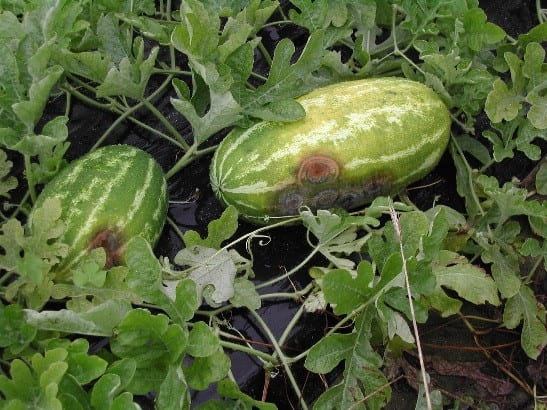Kate Everts, Vegetable Pathologist, University of Delaware and University of Maryland; keverts@umd.edu
Weather conditions continue to be very favorable for the development of Phytophthora fruit rot on watermelons. Conditions that favor Phytophthora fruit rot are rainfall amounts that lead to saturated fields for several hours. When soil is saturated for 5 to 6 hours, the disease progress is greatly increased. Optimum temperature for the disease is 82°F, however higher temperatures won’t stop the progress of the disease.
The first step in management of Phytophthora fruit rot is to implement good cultural disease management practices such as removing infected debris and diseased fruit from fields, using raised beds, and improving soil drainage through tillage or creating ditches. Phytopthora blight has a wide host range, so avoid susceptible host plants in the field rotation (snap and lima bean, cucurbits, eggplants and tomatoes).
Several research trials have been conducted on Phytophthora fruit rot by Dr. S. Kousik in South Carolina to evaluate efficacy of fungicides. He found that Orondis, Revus, Presidio and Zampro were the products that were most often included in the best treatment programs. For example, in 2015, foliar sprays of Zampro alternated with Orondis, and Revus alternated with Presidio reduced fruit rot by about 80% compared to non-sprayed plots. Note that although 80% reduction in fruit rot sounds great, 12% of fruit were still diseased. Other trials have only achieved 60 or 75% fruit rot reduction with the best treatments. Therefore, even in treated fields many fruit won’t be harvestable.
In an earlier trial conducted before Orondis was available, a good program for Phytophthora fruit rot was Actigard plus Prophtye plus Kocide applied and alternated with an application that includes Zampro, Revus or Presidio. Zampro, Revus and Presidio applied before harvest reduced post-harvest rot.
Watermelon fruit are susceptible to Phytophthora fruit rot at all growth stages. Therefore sprays targeted for Phytophthora fruit rot should begin when fruit are approximately orange to grapefruit size.
Phytophthora fruit rot on watermelon
“Felt-like” Phytophthora sporulation on cantaloupe fruit.


